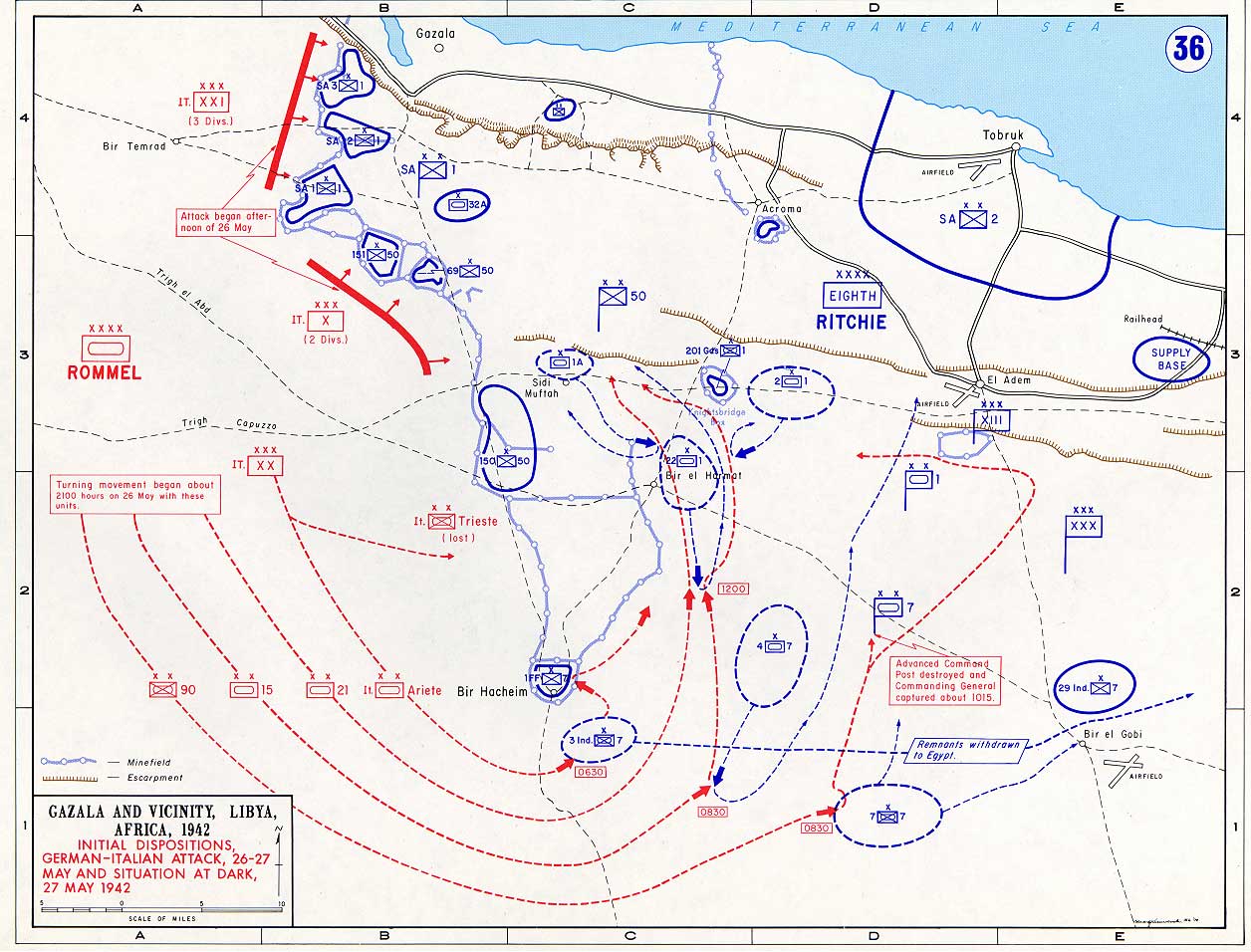The Sandman
MEMBER
A bit of background
After the defeat in "Operation Crusader" in late 1941 the axis forces had retreated to a defensive line at "El Agheila" the British at the time assumed that Rommels DAK (Deutsches Afrika Korps) is behind fortifications now so British forces (8th Army) under General Sir Claude Auchinleck and Major General Neil Ritchie did not attacked instead they consolidated their positions also 8th army after advance of 800km had already overstretched it's supplies.
On 21st Jan 1942 Rommel sent out three armored reconnaissance columns but as Rommel was he grabbed the opportunity and turned it into an offensive and on 28th Jan he re-captured Benghazi and on 3rd Feb Timimi. After this British fell back to a line stretching from Gazala to Bir Hakeim.
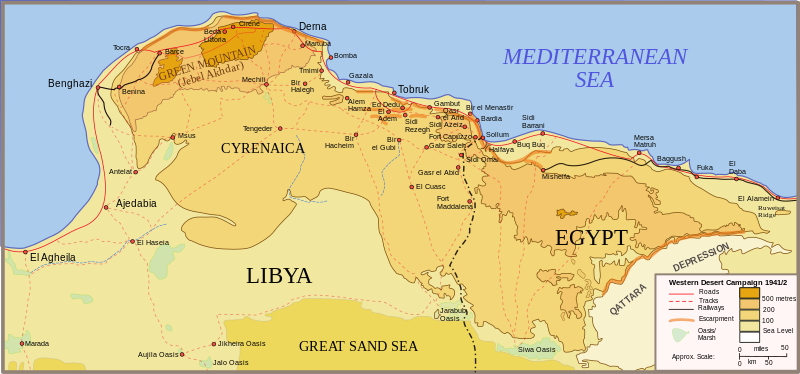
Commanders
Axis: Erwin Rommel aka "Desert Fox" and Ettore Bastico
Allies: Claude Auchinleck and Neil Ritchie
Numbers
The allies overestimated the casualties they inflicted upon axis during OP Crusader. The allies thought total axis fighting strength is around 35,000 men where as in reality axis forces had total strength of 80,000 men (50,000 of whom were Germans rest Italians) and in total 560 tanks. The Allies on the other hand had over 100,000 men an 850 tanks and over 140 in reserve.
Axis Army
Afrika Korps (commanded by Lt. Gen Nehring) contained 15th Panzer Division, 21st Panzer Divison, the mobile elements of 90th Light Division and three Reconnaissance Battalions (Nos.3, 33 and 580).
XX Italian Corps contained the Ariete armoured and Trieste motorised divisions.
Group Cruewell was a largely infantry force and contained the X Italian Corps, XXI Italian Corps, the HQ of the XV German Lorried Infantry Brigade
Equipment
Tanks at Rommels disposal
-251 Pz III's of which on 19 were armed with the long L/60 50mm Gun rest were old Pz III's.
-42 Pz IV armed with short barreled 75mm.
-50 Pz II's
-228 Italian tanks
Aircrafts
-500 (not much info available on it)
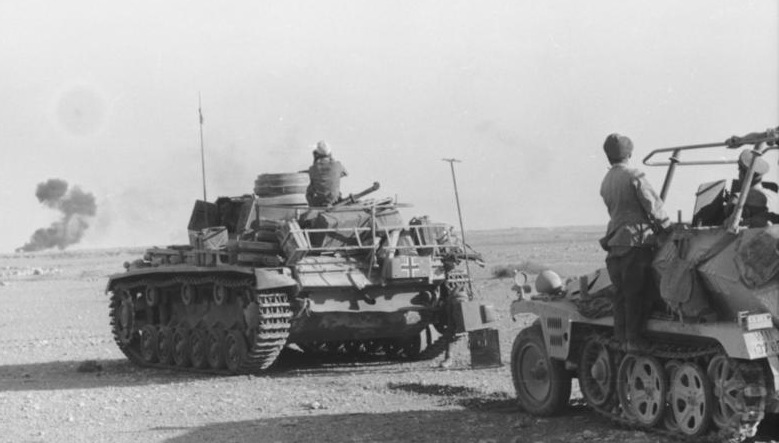
Panzer III and Rommels command car during Gaza battles
Allied Army
British 8th Army responsible for operations in Libya was split into two corps XXX corps containing the 1st and 7th Armoured Divisions.
XIII Corps containing 50th (Northumbrian) Division, 1st South Africa Division and 2nd South Africa Division.
Equipment
-167 M3 Grant medium tanks
-149 M3 Stuart light tanks
-257 Crusader cruiser tanks
(Commanded by 1st and 7th Armored).
-166 Valentines and 110 Matilda IIs
(Under command of XIII Corps).
Aircrafts
-200
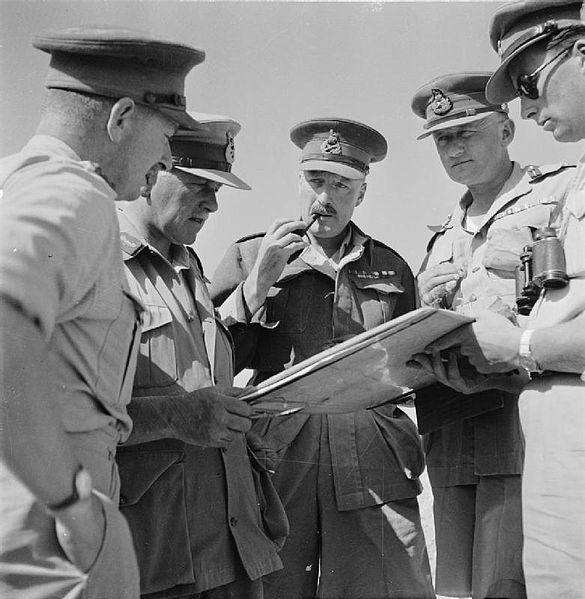
General Ritchie addressing his commanders, 31 May 1942
Rommel's Plan
Rommel planned to use Cruewell's infantry to launch a feint against the main Gazala line. Once this was well underway he would lead the Afrika Korps on an outflanking attack which would pass to the south of Bir Hakeim. While the XX Italian Corps dealt with Bir Hakeim, the German armour would swing north and advance behind the British front line towards Acroma, half way between Tobruk and the main Gazala Line. This would provoke a tank battle in which the Allied armour would be destroyed.
90th Light Division would be sent east through El Adem heading for the coast east of Tobruk, to prevent reinforcements reaching the port from Egypt (as had happened before the siege of Tobruk in the previous year). Rommel would then crush the defences of Tobruk before the defenders could prepare for another siege. The bulk of the Allied infantry would be trapped in the Gazala position, unable to interfere further east. The main strike force was given enough fuel for 482km and enough supplies for 96 hours of operations. Fresh supplies were to come along the Trigh Capuzzo and Trigh el Abd, two tracks that Rommel believed passed through the Gazala line between the northern boxes and the isolated garrison of Bir Hakeim. This was the biggest weakness in Rommel's plan – he was unaware of the existence of the 150th Brigade Group Box, which blocked these tracks.
Rommel's outflanking move was given the name Operation Venezia.
Allied Plan
The Allies were depending on the Gazala Line to repel any Axis attack this line was a large minefield than ran south from the coast near Gazala for 69km. A series of defensive 'keeps' or 'boxes' had been built within the minefields, each intended to hold a brigade group and all of its supplies. A second line was under construction, running east frm Sidi Muftah to El Adem.
The BIG day
Operation Venezia
At 14:00 on 26 May, the Italian X and XXI Corps, after a heavy artillery concentration, launched a frontal attack on the central Gazala positions, beginning Unternemen Venezia (Operation Venice). Involving four Italian divisions and a German infantry brigade, they soon reached the Allied lines. Rommel's strike force formed up just to the south of Cruewell's attack, before late in the day it moved off to the south-east. The two Italian divisions (Trieste and Ariete) were on the left, the 90th Light Division on the right, and 15 Panzer and 21 Panzer in the centre. By the early morning of 27 May most of this force was in place to the south of Bir Hakeim, but the Trieste division got lost in the dark, veered off to the left and headed for the 150th Brigade Group box, as yet unknown to the Germans.
In the early hours of 27 May, Rommel led the elements of Panzerarmee Afrika, the(DAK), Italian XX Motorised Corps and the German 90th Light Afrika Division, in a bold flanking move around the southern end of the Allied line, using the British minefields to protect the Axis flank and rear.
The first clash came with the 3rd Indian Motorised Brigade, which was positioned to the south-east of Bir Hakeim. This was attacked by Ariete and 21 Panzer and scattered with the loss of 440 men. Ariete was then sent to attack the Bir Hakeim box. On the German right 90th Light ran into the 7th Motorised Brigade at Retma, 24km further to the east. The British managed to escape to the east, heading for Bir el Gubi, but leaving the route to El Adem unguarded. The first British response ended badly.
4th Armoured Brigade, which was posted to the north of 7th Motorised, attempted to help the Indians, but ended up exposed to a flank attack by 15 Panzer. This time the fighting was more even, and the 75mm armed Grant came as a nasty surprise to the Germans, but the 4th Armoured Brigade ended up retreating to the north-east. Another column from 15 Panzer had some luck, finding the HQ of the 7th Armoured Division at Bir Beuid (where it had originally been protected by the two Armoured Brigades), and captured Major-General Messervy, the divisional commander, and most of his staff but he later escaped.
As the Germans moved north, they kept running into fresh British armoured formations. Next was 22nd Armoured Brigade (1st Armoured Division), but this formation ran into both German panzer divisions and was forced to retreat after losing 30 tanks. As the retreating 22nd Armoured moved back towards the Knightsbridge position (a British administrative centre on the Trigh Capuzzo track), the pursuing Germans were attacked from the east by the 2nd Armoured Brigade and from the west by the 1st Army Tank Brigade. The main thrust towards Knightsbridge was held up by this opposition. One column from 15 Panzer, operating on the German right, reached Bir Lefa, on the track running east from Knightsbridge, and 90th Light Division continued to push towards El Adem, but elsewhere the Ariete attack on Bir Hakeim failed, and the precious supply convoys were missing. By the end of the day Rommel may have lost up to one third of his tanks, and he was running short of fuel and water.
On 28 May Rommel continued to push north. 21 Panzer reached Commonwealth Keep, a smaller British position near the top of the escarpment that overlooked the coast road. Ariete, following the Germans north, ran into 2nd Armoured Brigade at Bir el Harmat, to the south of Knightsbridge, and had the worst of a hard fought battle. 90th Light's attack on El Adem was foiled by the 4th Armoured Brigade. By the end of the day Rommel was dangerously short of supplies, and apparently isolated on the wrong side of the Gazala line. This would have been a good time for a British counterattack, but Ritchie decided to wait and see.
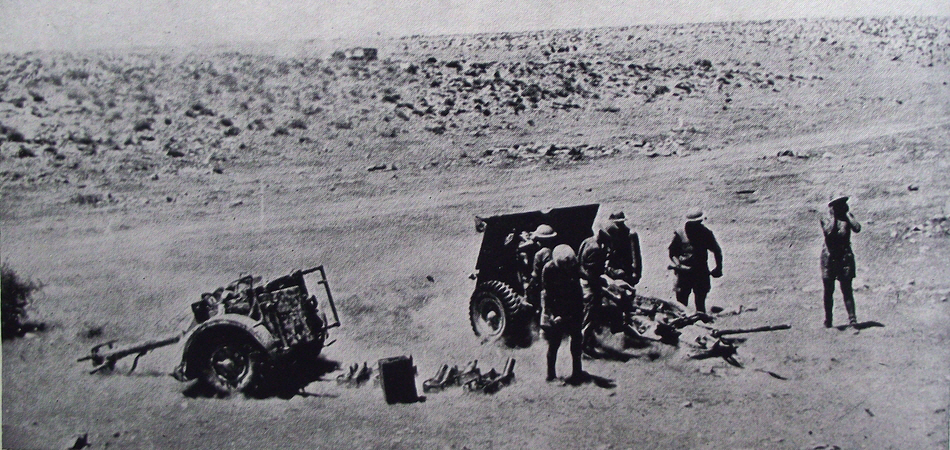
25-pounder field gun in action during the fighting in the 'Knightsbridge' area.
The overall plan was rash, and by accompanying the outflanking movement Rommel had cut himself off from his own Army HQ. His air support couldn't act, as they didn't know where their own forces were. Cruewell had no idea where his boss was.
BUT Rommel was also an inspirational leader. Late on 28 May he decided to concentrate his forces to the south-west of Knightsbridge, and he then left to try and find his supply convoys. During the night he found the vulnerable trucks, and personally led them north to bring vital supplies to the Afrika Korps.
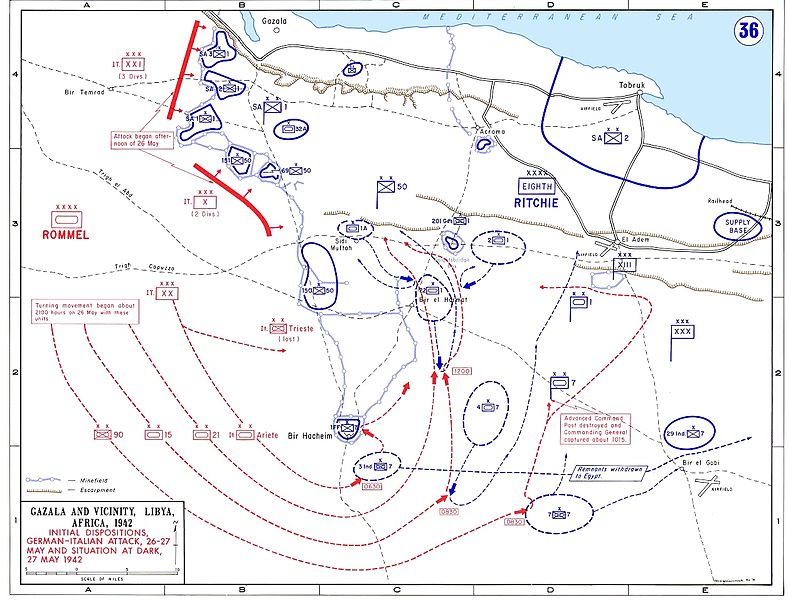
Axis advance, opening of Operation Venice
Bir Hakeim
The Bir Hakeim box was defended by the 1st Free French Brigade under Marie-Pierre Koenig. Italian tank battalion of the "Ariete" Division, stumbled in the French positions and launched a hasty attack, which was a costly failure against the French 75 mm guns and mines. But on 9 June reinforced with a further combat group, the Axis attacked Bir Hakeim again on 9 June and overran the defences by the following day. Under fire through the night, many of the French were able to find gaps in the line and made their way some 8 km to the west, to rendezvous with transport from the 7th Motor Brigade. About 2,700 troops (including 200 wounded) of the original garrison of 3,600 escaped and about 500 French troops, many of whom were wounded, were captured when the 90th Light Division occupied the position on 11 June.
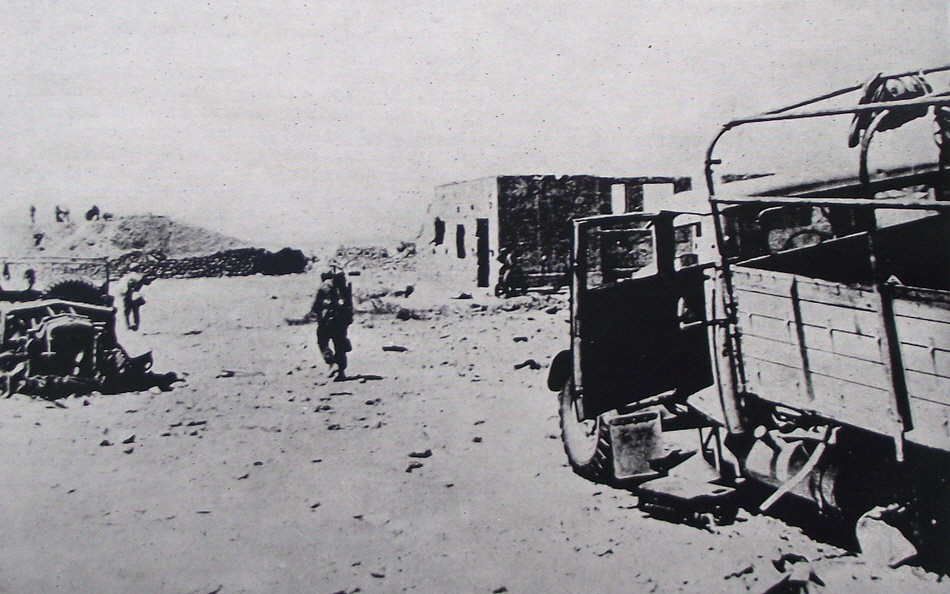
Bir Hakeim after the battle of Gazala
The Cauldron
29 May saw the start of a prolonged period of fighting in a shallow depression known as the 'Cauldron', between Knightsbridge and the 150th Brigade Group Box. despite some heavy fighting with 2nd and 22nd Armoured Brigades. An attempt by the Italian Sabratha Division to break through the Gazala Line was repulsed by 1st South African Division, so Rommel was still isolated. He also lost one of his most trusted subordinates. General Cruewell was captured when his aircraft flew over an unknown British position and shot down. By chance Kesselring was in Africa at the time, and he took temporary control of Cruewell's force.
Rommel now decided to change his plan. He would go onto the defensive on the eastern edge of the British minefields. His antitank guns would form a defensive line to deal with any British counterattack, while his engineers opened a line through the minefields. He would use that to resupply his panzers. The one problem with this plan was that Rommel had only now discovered the 150th Brigade Group Box, which sat exactly in his way.
By the morning of 30 May Rommel's engineers had made one narrow line through the minefields, and were thus in contact with the rest of his army. However this line ran just to the north of the 150th Brigade Box, and was under constant artillery fire. Further south Bir Hakeim still held out. Rommel decided to focus all of his offensive resources against the Box, while his guns fought off any British counterattack. This was the crisis of the battle. Rommel was running short of water once again, and admitted to one of his prisoners that if he didn't get any more then he might have to surrender. A major 8th Army counterattack at this stage might have been disastrous for Rommel, but Ritchie still failed to move.
"In the afternoon [30th May] I personally reconnoitred the possibilities for an attack on Got el Ualeb [the Sidi Muftah box] and detailed units of the Afrika Korps, 90th Light Division and the Italian Trieste Division for an assault on the British positions next morning. The attack was launched on the morning of the 31st May. German-Italian units fought their way forward yard by yard against the toughest British resistance imaginable.[...] Nevertheless, by the time evening came we had penetrated a substantial distance into the British positions. On the following day the defenders were to receive their quietus. After heavy Stuka attacks, the infantry again surged forward against the British field positions.[...] Piece by piece the elaborate British defences were won until by early afternoon the whole position was ours. The last British resistance was quenched. We took in all 3,000 prisoners and destroyed or captured 101 tanks and armoured cars, as well as 124 guns of all kinds." - Rommel
Acting on mistaken reports about German tank losses, Auchinleck strongly urged Ritchie to counter-attack along the coast, to exploit the absence of German tanks and break through to Timimi and then Mechili.
Finally on 5th June Ritchie ordered the Eighth Army to counter-attack against the Afrika Korps on 5 June but they were met by accurate fire from tank and anti-tank guns positioned in the cauldron. In the north, XIII Corps made no progress but the attack by 7th Armoured and 5th Indian divisions on the eastern flank of the cauldron at 02:50, initially went well. An important element of the plan was the destruction of the Axis anti-tank screen with an artillery bombardment but because of an error in plotting its position, the bombardment fell too far to the east. When the 22nd Armoured Brigade advanced, it was met by massed anti-tank fire and the advance was checked. The 32nd Army Tank Brigade advancing from the north, joined the attack at dawn but also ran into massed fire, losing fifty of seventy tanks. But failure was so severe that Rommel decided to launch his own counterattack later on the same day. This was much better handled – the British attackers were overrun, and the British lost around 6,000 men and 150 tanks.
Black Sunday
On 11 June Rommel launched a two-pronged assault. 21 Panzer attacked in the north, heading east along Sidra Ridge. 15 Panzer and 90th Light were attacked in the south, heading east towards El Adem. On the British side General Norrie attempted to organise a counterattack, but General Messervy (who had escaped from his brief captivity) went missing on his way to the crucial planning conference and the attack never happened.
On 13 June, the 21st Panzer Division advanced from the west to join the battle, engaging the 22nd Armoured Brigade. The Afrika Korps demonstrated a superiority in tactics, combining tanks with anti-tank guns while on the offensive; Rommel acted rapidly on intelligence obtained from Allied radio traffic intercepts. By the end of the day, the British tank strength had been reduced from 300 tanks to about 70 and the Afrika Korps had established armour superiority and a dominating line of positions, posing a severe threat to cutting off the XIII Corps units on the Gazala line. By the end of 13 June, the Knightsbridge box was virtually surrounded and it was abandoned by the Guards Brigade later that night. Due to these defeats, 13 June became known as "Black Saturday" to the Eighth Army.
8th Army Retreat
On 14 June, Auchinleck authorised Ritchie to withdraw from the Gazala line. The defenders in the El Adem and two neighbouring boxes held firm and the 1st South African Division was able to withdraw along the coast road, practically intact. Ritchie wanted to withdraw all the way to the Egyptian border, accepting a second siege of Tobruk. Auchinleck didn't want another siege, and instead ordered Ritchie to hold a new line that ran south from Acroma (west of Tobruk), south-east to El Adem and then south to Bir el Gubi.
The retreat began fairly successfully. The 1st South African Division was back around Tobruk by the morning of 15 June. 50th Division managed a dramatic move that Rommel would have been proud of. Aware that the Germans now dominated the area to their east, General Ramsden decided to attack west, break a hole in the Italian line, then swing south, and follow Rommel's earlier route to the south of Bir Hakeim. By 0400 on 14 June the breakthrough had been completed, and the division turned south. They safely made it around Bir Hakeim, and then headed east across the desert. Around 96% of the troops involved in the breakout managed to reach the Egyptian frontier safely. Throughout the day, the defensive boxes at El Adem and Sidi Rezegh were also attacked by the Afrika Korps.
On 17 June, both were evacuated and any chance of preventing the encirclement of Tobruk vanished. Ritchie ordered the Eighth Army to withdraw to the defensive positions at Mersa Matruh, some 160 km east of the frontier, leaving Tobruk to hold out and threaten the Axis lines of communication, in much the same way as in 1941.
Fall of Tobruk
The fighting now moved to the Tobruk area. Ritchie and Auchinleck disagreed about what to do about Tobruk, with Ritchie willing to accept a second siege, and Auchinleck insistent that the new defensive line should include Tobruk. The Germans soon took the decision out of their hands.
On the night of 16/17 June General Norrie was forced to abandon El Adem, to the south of Tobruk. Late on 17 June the 4th Armoured Brigade had to withdraw from Sidi Rezegh, to the south-east of Tobruk. The port was now besieged for a second time, but this time it wouldn't hold out for any length of time.
On 20 June Rommel launched a full scale assault on the south-eastern side of the defences, and by the end of the day he was in the port. Early on 21 June General Klopper, the Allied commander in Tobruk, was forced to surrender.
35,000 Allied troops surrendered.
Tobruk had withstood a siege of nine months, before being relieved by Operation Crusader in December 1941. Allied leaders expected it to be able to hold out for two months with the supplies in the fortress.
AFTERMATH
-Hitler rewarded Rommel with a promotion to the rank of field-marshal, the youngest German officer ever to achieve this rank.
-With the capture of Tobruk, the Axis gained a port nearer the Aegean–Crete route and a large amount of British supplies.
-Auchinleck dismissed Ritchie on 25 June and assumed command of the Eighth Army.
-In August, Auchinleck was replaced as Eighth Army commander by the XIII Corps commander.
Casualties
Allies
-Casualties amounted to 90,000 men (either killed, wounded or missing 32,000 captured)
-540 tanks (destroyed, damaged or captured)
Axis
-3360 men killed, captured or wounded. (I can't confirm the axis casualties a lot of conflicting reports.
-114 Tank destroyed, damaged or captured
Sources
1
2
3
 Hope you guys will enjoy reading about this great battle!
Hope you guys will enjoy reading about this great battle!
@Arslan (there you go ) @Joe Shearer @Khafee @I.R.A @Hithchiker @Nilgiri (gotta tag you bro
) @Joe Shearer @Khafee @I.R.A @Hithchiker @Nilgiri (gotta tag you bro  ) I apologize if i am forgetting anyone else.
) I apologize if i am forgetting anyone else.
Edit- Had to remove a few pics as it was messing up the whole thing is it a bug? @WebMaster
After the defeat in "Operation Crusader" in late 1941 the axis forces had retreated to a defensive line at "El Agheila" the British at the time assumed that Rommels DAK (Deutsches Afrika Korps) is behind fortifications now so British forces (8th Army) under General Sir Claude Auchinleck and Major General Neil Ritchie did not attacked instead they consolidated their positions also 8th army after advance of 800km had already overstretched it's supplies.
On 21st Jan 1942 Rommel sent out three armored reconnaissance columns but as Rommel was he grabbed the opportunity and turned it into an offensive and on 28th Jan he re-captured Benghazi and on 3rd Feb Timimi. After this British fell back to a line stretching from Gazala to Bir Hakeim.

Commanders
Axis: Erwin Rommel aka "Desert Fox" and Ettore Bastico
Allies: Claude Auchinleck and Neil Ritchie
Numbers
The allies overestimated the casualties they inflicted upon axis during OP Crusader. The allies thought total axis fighting strength is around 35,000 men where as in reality axis forces had total strength of 80,000 men (50,000 of whom were Germans rest Italians) and in total 560 tanks. The Allies on the other hand had over 100,000 men an 850 tanks and over 140 in reserve.
Axis Army
Afrika Korps (commanded by Lt. Gen Nehring) contained 15th Panzer Division, 21st Panzer Divison, the mobile elements of 90th Light Division and three Reconnaissance Battalions (Nos.3, 33 and 580).
XX Italian Corps contained the Ariete armoured and Trieste motorised divisions.
Group Cruewell was a largely infantry force and contained the X Italian Corps, XXI Italian Corps, the HQ of the XV German Lorried Infantry Brigade
Equipment
Tanks at Rommels disposal
-251 Pz III's of which on 19 were armed with the long L/60 50mm Gun rest were old Pz III's.
-42 Pz IV armed with short barreled 75mm.
-50 Pz II's
-228 Italian tanks
Aircrafts
-500 (not much info available on it)

Panzer III and Rommels command car during Gaza battles
Allied Army
British 8th Army responsible for operations in Libya was split into two corps XXX corps containing the 1st and 7th Armoured Divisions.
XIII Corps containing 50th (Northumbrian) Division, 1st South Africa Division and 2nd South Africa Division.
Equipment
-167 M3 Grant medium tanks
-149 M3 Stuart light tanks
-257 Crusader cruiser tanks
(Commanded by 1st and 7th Armored).
-166 Valentines and 110 Matilda IIs
(Under command of XIII Corps).
Aircrafts
-200

General Ritchie addressing his commanders, 31 May 1942
Rommel's Plan
Rommel planned to use Cruewell's infantry to launch a feint against the main Gazala line. Once this was well underway he would lead the Afrika Korps on an outflanking attack which would pass to the south of Bir Hakeim. While the XX Italian Corps dealt with Bir Hakeim, the German armour would swing north and advance behind the British front line towards Acroma, half way between Tobruk and the main Gazala Line. This would provoke a tank battle in which the Allied armour would be destroyed.
90th Light Division would be sent east through El Adem heading for the coast east of Tobruk, to prevent reinforcements reaching the port from Egypt (as had happened before the siege of Tobruk in the previous year). Rommel would then crush the defences of Tobruk before the defenders could prepare for another siege. The bulk of the Allied infantry would be trapped in the Gazala position, unable to interfere further east. The main strike force was given enough fuel for 482km and enough supplies for 96 hours of operations. Fresh supplies were to come along the Trigh Capuzzo and Trigh el Abd, two tracks that Rommel believed passed through the Gazala line between the northern boxes and the isolated garrison of Bir Hakeim. This was the biggest weakness in Rommel's plan – he was unaware of the existence of the 150th Brigade Group Box, which blocked these tracks.
Rommel's outflanking move was given the name Operation Venezia.
Allied Plan
The Allies were depending on the Gazala Line to repel any Axis attack this line was a large minefield than ran south from the coast near Gazala for 69km. A series of defensive 'keeps' or 'boxes' had been built within the minefields, each intended to hold a brigade group and all of its supplies. A second line was under construction, running east frm Sidi Muftah to El Adem.
The BIG day
Operation Venezia
At 14:00 on 26 May, the Italian X and XXI Corps, after a heavy artillery concentration, launched a frontal attack on the central Gazala positions, beginning Unternemen Venezia (Operation Venice). Involving four Italian divisions and a German infantry brigade, they soon reached the Allied lines. Rommel's strike force formed up just to the south of Cruewell's attack, before late in the day it moved off to the south-east. The two Italian divisions (Trieste and Ariete) were on the left, the 90th Light Division on the right, and 15 Panzer and 21 Panzer in the centre. By the early morning of 27 May most of this force was in place to the south of Bir Hakeim, but the Trieste division got lost in the dark, veered off to the left and headed for the 150th Brigade Group box, as yet unknown to the Germans.
In the early hours of 27 May, Rommel led the elements of Panzerarmee Afrika, the(DAK), Italian XX Motorised Corps and the German 90th Light Afrika Division, in a bold flanking move around the southern end of the Allied line, using the British minefields to protect the Axis flank and rear.
The first clash came with the 3rd Indian Motorised Brigade, which was positioned to the south-east of Bir Hakeim. This was attacked by Ariete and 21 Panzer and scattered with the loss of 440 men. Ariete was then sent to attack the Bir Hakeim box. On the German right 90th Light ran into the 7th Motorised Brigade at Retma, 24km further to the east. The British managed to escape to the east, heading for Bir el Gubi, but leaving the route to El Adem unguarded. The first British response ended badly.
4th Armoured Brigade, which was posted to the north of 7th Motorised, attempted to help the Indians, but ended up exposed to a flank attack by 15 Panzer. This time the fighting was more even, and the 75mm armed Grant came as a nasty surprise to the Germans, but the 4th Armoured Brigade ended up retreating to the north-east. Another column from 15 Panzer had some luck, finding the HQ of the 7th Armoured Division at Bir Beuid (where it had originally been protected by the two Armoured Brigades), and captured Major-General Messervy, the divisional commander, and most of his staff but he later escaped.
As the Germans moved north, they kept running into fresh British armoured formations. Next was 22nd Armoured Brigade (1st Armoured Division), but this formation ran into both German panzer divisions and was forced to retreat after losing 30 tanks. As the retreating 22nd Armoured moved back towards the Knightsbridge position (a British administrative centre on the Trigh Capuzzo track), the pursuing Germans were attacked from the east by the 2nd Armoured Brigade and from the west by the 1st Army Tank Brigade. The main thrust towards Knightsbridge was held up by this opposition. One column from 15 Panzer, operating on the German right, reached Bir Lefa, on the track running east from Knightsbridge, and 90th Light Division continued to push towards El Adem, but elsewhere the Ariete attack on Bir Hakeim failed, and the precious supply convoys were missing. By the end of the day Rommel may have lost up to one third of his tanks, and he was running short of fuel and water.
On 28 May Rommel continued to push north. 21 Panzer reached Commonwealth Keep, a smaller British position near the top of the escarpment that overlooked the coast road. Ariete, following the Germans north, ran into 2nd Armoured Brigade at Bir el Harmat, to the south of Knightsbridge, and had the worst of a hard fought battle. 90th Light's attack on El Adem was foiled by the 4th Armoured Brigade. By the end of the day Rommel was dangerously short of supplies, and apparently isolated on the wrong side of the Gazala line. This would have been a good time for a British counterattack, but Ritchie decided to wait and see.

25-pounder field gun in action during the fighting in the 'Knightsbridge' area.
The overall plan was rash, and by accompanying the outflanking movement Rommel had cut himself off from his own Army HQ. His air support couldn't act, as they didn't know where their own forces were. Cruewell had no idea where his boss was.
BUT Rommel was also an inspirational leader. Late on 28 May he decided to concentrate his forces to the south-west of Knightsbridge, and he then left to try and find his supply convoys. During the night he found the vulnerable trucks, and personally led them north to bring vital supplies to the Afrika Korps.

Axis advance, opening of Operation Venice
Bir Hakeim
The Bir Hakeim box was defended by the 1st Free French Brigade under Marie-Pierre Koenig. Italian tank battalion of the "Ariete" Division, stumbled in the French positions and launched a hasty attack, which was a costly failure against the French 75 mm guns and mines. But on 9 June reinforced with a further combat group, the Axis attacked Bir Hakeim again on 9 June and overran the defences by the following day. Under fire through the night, many of the French were able to find gaps in the line and made their way some 8 km to the west, to rendezvous with transport from the 7th Motor Brigade. About 2,700 troops (including 200 wounded) of the original garrison of 3,600 escaped and about 500 French troops, many of whom were wounded, were captured when the 90th Light Division occupied the position on 11 June.

Bir Hakeim after the battle of Gazala
The Cauldron
29 May saw the start of a prolonged period of fighting in a shallow depression known as the 'Cauldron', between Knightsbridge and the 150th Brigade Group Box. despite some heavy fighting with 2nd and 22nd Armoured Brigades. An attempt by the Italian Sabratha Division to break through the Gazala Line was repulsed by 1st South African Division, so Rommel was still isolated. He also lost one of his most trusted subordinates. General Cruewell was captured when his aircraft flew over an unknown British position and shot down. By chance Kesselring was in Africa at the time, and he took temporary control of Cruewell's force.
Rommel now decided to change his plan. He would go onto the defensive on the eastern edge of the British minefields. His antitank guns would form a defensive line to deal with any British counterattack, while his engineers opened a line through the minefields. He would use that to resupply his panzers. The one problem with this plan was that Rommel had only now discovered the 150th Brigade Group Box, which sat exactly in his way.
By the morning of 30 May Rommel's engineers had made one narrow line through the minefields, and were thus in contact with the rest of his army. However this line ran just to the north of the 150th Brigade Box, and was under constant artillery fire. Further south Bir Hakeim still held out. Rommel decided to focus all of his offensive resources against the Box, while his guns fought off any British counterattack. This was the crisis of the battle. Rommel was running short of water once again, and admitted to one of his prisoners that if he didn't get any more then he might have to surrender. A major 8th Army counterattack at this stage might have been disastrous for Rommel, but Ritchie still failed to move.
"In the afternoon [30th May] I personally reconnoitred the possibilities for an attack on Got el Ualeb [the Sidi Muftah box] and detailed units of the Afrika Korps, 90th Light Division and the Italian Trieste Division for an assault on the British positions next morning. The attack was launched on the morning of the 31st May. German-Italian units fought their way forward yard by yard against the toughest British resistance imaginable.[...] Nevertheless, by the time evening came we had penetrated a substantial distance into the British positions. On the following day the defenders were to receive their quietus. After heavy Stuka attacks, the infantry again surged forward against the British field positions.[...] Piece by piece the elaborate British defences were won until by early afternoon the whole position was ours. The last British resistance was quenched. We took in all 3,000 prisoners and destroyed or captured 101 tanks and armoured cars, as well as 124 guns of all kinds." - Rommel
Acting on mistaken reports about German tank losses, Auchinleck strongly urged Ritchie to counter-attack along the coast, to exploit the absence of German tanks and break through to Timimi and then Mechili.
Finally on 5th June Ritchie ordered the Eighth Army to counter-attack against the Afrika Korps on 5 June but they were met by accurate fire from tank and anti-tank guns positioned in the cauldron. In the north, XIII Corps made no progress but the attack by 7th Armoured and 5th Indian divisions on the eastern flank of the cauldron at 02:50, initially went well. An important element of the plan was the destruction of the Axis anti-tank screen with an artillery bombardment but because of an error in plotting its position, the bombardment fell too far to the east. When the 22nd Armoured Brigade advanced, it was met by massed anti-tank fire and the advance was checked. The 32nd Army Tank Brigade advancing from the north, joined the attack at dawn but also ran into massed fire, losing fifty of seventy tanks. But failure was so severe that Rommel decided to launch his own counterattack later on the same day. This was much better handled – the British attackers were overrun, and the British lost around 6,000 men and 150 tanks.
Black Sunday
On 11 June Rommel launched a two-pronged assault. 21 Panzer attacked in the north, heading east along Sidra Ridge. 15 Panzer and 90th Light were attacked in the south, heading east towards El Adem. On the British side General Norrie attempted to organise a counterattack, but General Messervy (who had escaped from his brief captivity) went missing on his way to the crucial planning conference and the attack never happened.
On 13 June, the 21st Panzer Division advanced from the west to join the battle, engaging the 22nd Armoured Brigade. The Afrika Korps demonstrated a superiority in tactics, combining tanks with anti-tank guns while on the offensive; Rommel acted rapidly on intelligence obtained from Allied radio traffic intercepts. By the end of the day, the British tank strength had been reduced from 300 tanks to about 70 and the Afrika Korps had established armour superiority and a dominating line of positions, posing a severe threat to cutting off the XIII Corps units on the Gazala line. By the end of 13 June, the Knightsbridge box was virtually surrounded and it was abandoned by the Guards Brigade later that night. Due to these defeats, 13 June became known as "Black Saturday" to the Eighth Army.
8th Army Retreat
On 14 June, Auchinleck authorised Ritchie to withdraw from the Gazala line. The defenders in the El Adem and two neighbouring boxes held firm and the 1st South African Division was able to withdraw along the coast road, practically intact. Ritchie wanted to withdraw all the way to the Egyptian border, accepting a second siege of Tobruk. Auchinleck didn't want another siege, and instead ordered Ritchie to hold a new line that ran south from Acroma (west of Tobruk), south-east to El Adem and then south to Bir el Gubi.
The retreat began fairly successfully. The 1st South African Division was back around Tobruk by the morning of 15 June. 50th Division managed a dramatic move that Rommel would have been proud of. Aware that the Germans now dominated the area to their east, General Ramsden decided to attack west, break a hole in the Italian line, then swing south, and follow Rommel's earlier route to the south of Bir Hakeim. By 0400 on 14 June the breakthrough had been completed, and the division turned south. They safely made it around Bir Hakeim, and then headed east across the desert. Around 96% of the troops involved in the breakout managed to reach the Egyptian frontier safely. Throughout the day, the defensive boxes at El Adem and Sidi Rezegh were also attacked by the Afrika Korps.
On 17 June, both were evacuated and any chance of preventing the encirclement of Tobruk vanished. Ritchie ordered the Eighth Army to withdraw to the defensive positions at Mersa Matruh, some 160 km east of the frontier, leaving Tobruk to hold out and threaten the Axis lines of communication, in much the same way as in 1941.
Fall of Tobruk
The fighting now moved to the Tobruk area. Ritchie and Auchinleck disagreed about what to do about Tobruk, with Ritchie willing to accept a second siege, and Auchinleck insistent that the new defensive line should include Tobruk. The Germans soon took the decision out of their hands.
On the night of 16/17 June General Norrie was forced to abandon El Adem, to the south of Tobruk. Late on 17 June the 4th Armoured Brigade had to withdraw from Sidi Rezegh, to the south-east of Tobruk. The port was now besieged for a second time, but this time it wouldn't hold out for any length of time.
On 20 June Rommel launched a full scale assault on the south-eastern side of the defences, and by the end of the day he was in the port. Early on 21 June General Klopper, the Allied commander in Tobruk, was forced to surrender.
35,000 Allied troops surrendered.
Tobruk had withstood a siege of nine months, before being relieved by Operation Crusader in December 1941. Allied leaders expected it to be able to hold out for two months with the supplies in the fortress.
AFTERMATH
-Hitler rewarded Rommel with a promotion to the rank of field-marshal, the youngest German officer ever to achieve this rank.
-With the capture of Tobruk, the Axis gained a port nearer the Aegean–Crete route and a large amount of British supplies.
-Auchinleck dismissed Ritchie on 25 June and assumed command of the Eighth Army.
-In August, Auchinleck was replaced as Eighth Army commander by the XIII Corps commander.
Casualties
Allies
-Casualties amounted to 90,000 men (either killed, wounded or missing 32,000 captured)
-540 tanks (destroyed, damaged or captured)
Axis
-3360 men killed, captured or wounded. (I can't confirm the axis casualties a lot of conflicting reports.
-114 Tank destroyed, damaged or captured
Sources
1
2
3
@Arslan (there you go
Edit- Had to remove a few pics as it was messing up the whole thing is it a bug? @WebMaster
Last edited:


